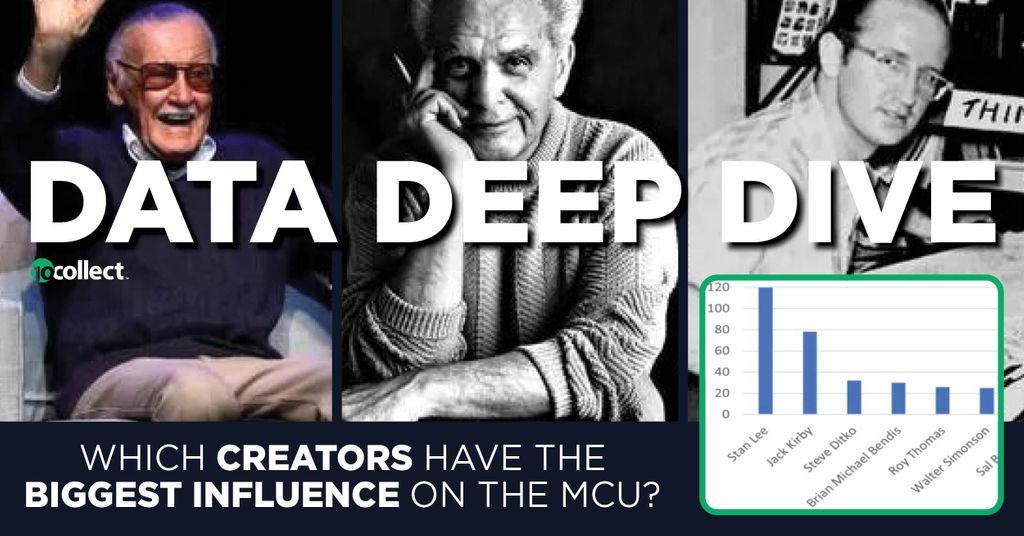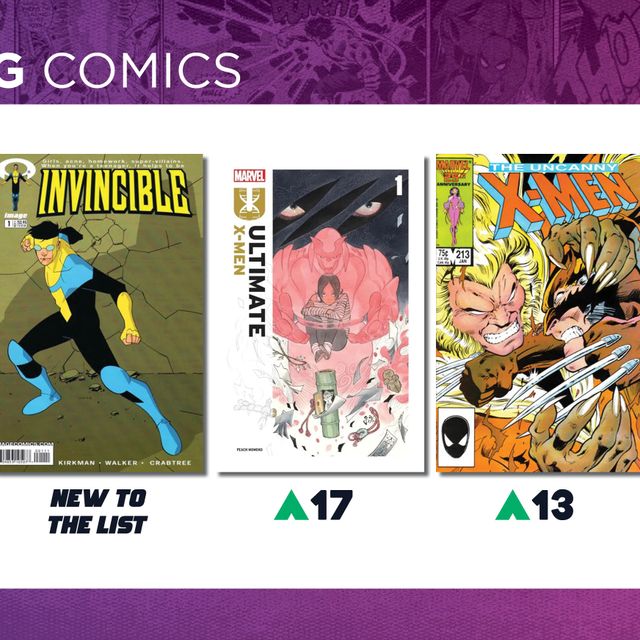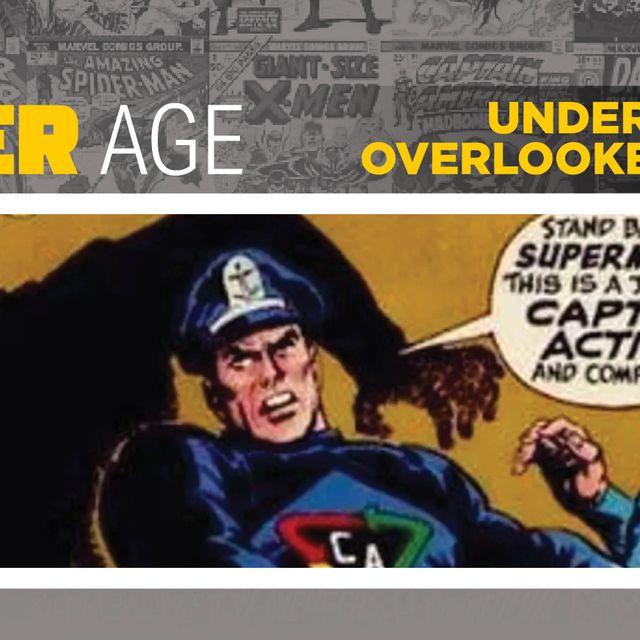I absolutely love the MCU. Getting to see the characters that I have loved and grown up with become fixtures of pop culture has been an absolute delight. Few moviegoing experiences were more special to me than when Cap called Mjolnir or when all three Peter Parkers teamed up together. As a comic book investor, I have found myself frequently thinking about the MCU and wondering which creators had the biggest impact on it. From that wondering came this article, an analysis of all the different comics that inspired the MCU and the fabulous creators who made it possible.
This article has been a true labor of love for me and I cannot thank GoCollect enough for giving me the opportunity to write it. Read on to find out more about the Marvel Cinematic Universe and the creative people who helped inspire it.
Methodology
- Data around comic book inspirations for various MCU projects was harvested from this list maintained on the Marvel Cinematic Universe Wiki.
- The comics from item one were cross-referenced with the Marvel Database wiki to determine who the writers and artists were for each individual comic
- The comics were organized into a spreadsheet that included additional categorical information on each MCU project, specifically what phase it was a part of and what franchise it was a part of (For example, Iron Man 2 is part of the Iron Man franchise, The Falcon and the Winter Soldier is a part of the Captain America franchise, etc)
- Data was analyzed to determine the number of creative credits each individual creator had, broken down across numerous dimensions.
Note: For the most part, the data was entered into the spreadsheet so that it matched the style of the original list. For example, the original list had the Extremis storyline (Iron Man Vol. 4 #1-6) as a single item instead of six individual issues. Thus, it was entered as a single item in the data spreadsheet
Note: For the purposes of keeping this article succinct, the graphs and analyses only examine the top ten creative individuals related to each specific subject, with a minimum requirement of two creative credits in order to be included. In the case of ties for the number ten spot, all tied individuals are listed.
High-Level Data
Breakdown By Creator
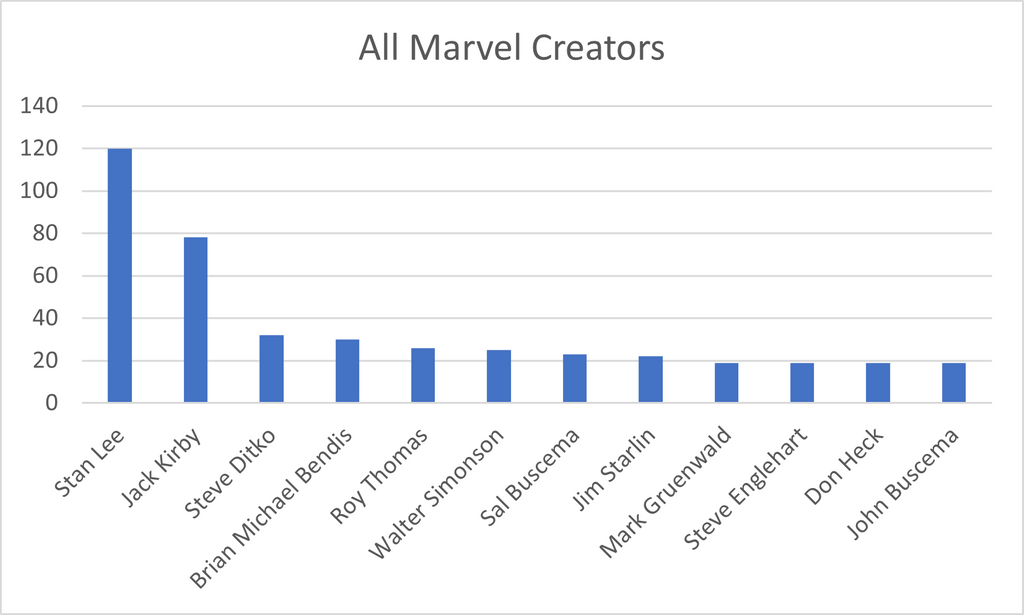
The first three people on this graph really should not be much of a surprise. Stan Lee, Jack Kirby, and, to a lesser degree, Steve Ditko, are essentially the godfathers of the Marvel Universe. Stan Lee of course has the most creative credits of anybody, in part because, unlike everyone else on this list, he basically never worked for anyone besides Marvel.
Some may be surprised that Bendis is in the number four spot, but it makes sense when one considers A. how insanely prolific he was at Marvel, and B. his role in creating and guiding the Ultimate Universe, which the MCU heavily borrows from.
Roy Thomas worked on just about every single character during his time at Marvel, so it only makes sense he would be one of the largest overall contributors.
Walter Simonson was the writer and artist for Thor for many years, so he essentially gets double credit for all of his work.
Sal and John Buscema and Don Heck were essentially the go-to artists at Marvel for the first few decades, so their influence is undeniable.
Jim Starlin essentially owned Marvel cosmic for several decades, so he benefited tremendously from all of the Guardians of the Galaxy projects and the cosmic nature of Infinity War and Endgame.
With the possible exception of Stan Lee, nobody has written Captain America more than Mark Gruenwald, so it makes sense he would be one of the top ten biggest contributors.
Finally, Steve Engelhart was very prolific at Marvel and worked with a lot of different characters and stories, especially the Avengers, so it's natural that he would be in the top tier as well.
Breakdown By Writer

David Michelinie's extensive work on Iron Man and intermittent work on The Avengers was heavily leveraged for the MCU, thus earning him a top spot.
Doug Moench benefited tremendously from Moon Knight and Shang-Chi showing up in Phase 4, as he wrote a lot of stories for both characters.
Both Gerry Conway and J Michael Straczynski wrote a lot of pivotal stories about Thor and Spider-Man, helping to ensure their placement in the top 10.
Jack Kirby is primarily credited as an artist, but he also did a tremendous amount of writing. As a result, he and Walt Simonson are the only people to appear on both the Top 10 Writers list and Top 10 Artists lists.
Mark Millar's foundational role in creating the Ultimate Universe also ensured he would be able to claim a top spot.
Breakdown By Artist

Both Romita Jr and Romita Sr were incredibly prolific during their respective times at Marvel, particularly when it comes to Spider-Man. Like the Buscema siblings, Al Milgrom was a go-to artist in Marvel's early decades and enjoyed an incredible amount of work as a result. Finally, Hitch's work on the Ultimate Universe is undeniable and has been frequently adapted for the MCU.
Breakdown By Phase
Phase 1 Breakdown
Iron Man, Incredible Hulk, Iron Man 2, Thor, Captain America: The First Avenger, Avengers
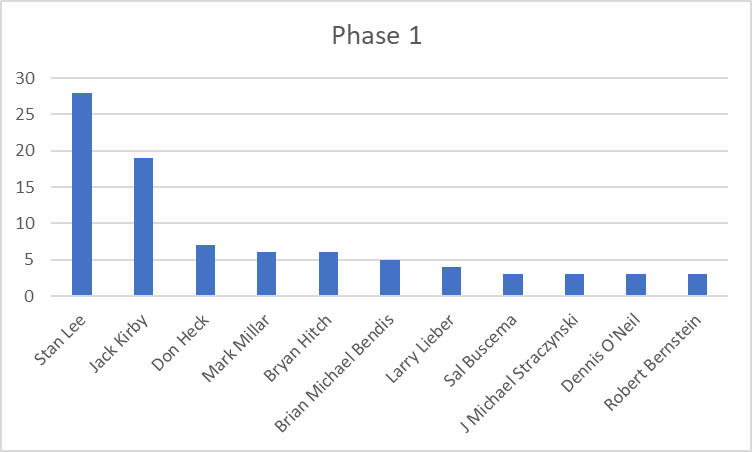
Phase 1 of the MCU was primarily characterized by origin stories. As a result, Stan Lee and Jack Kirby, who wrote just about all of those origins, have enormous influence. The same is true for Millar, Hitch, and Bendis, as Phase 1 heavily leveraged both the original and Ultimate Universe versions of the characters' respective origins.
Don Heck, Dennis O'Neil, and Robert Bernstein did a lot of work on Iron Man stories and no character shows up in Phase 1 more frequently than Iron Man.
Larry Lieber (the brother of Stan Lee) helped to write a lot of the early Thor stories, so it makes sense for him to be a major Phase 1 Contributor. Buscema was always a very prolific artist and had creative credits for every single Phase 1 film, but Iron Man.
Straczynski was arguably the architect of the modern incarnation of Thor and the story elements he created were heavily incorporated into the character's eponymous first film.
Phase 2 Breakdown
Iron Man 3, Thor: The Dark World, Captain America: The Winter Soldier, Guardians of the Galaxy, Avengers: Age of Ultron, Ant-Man
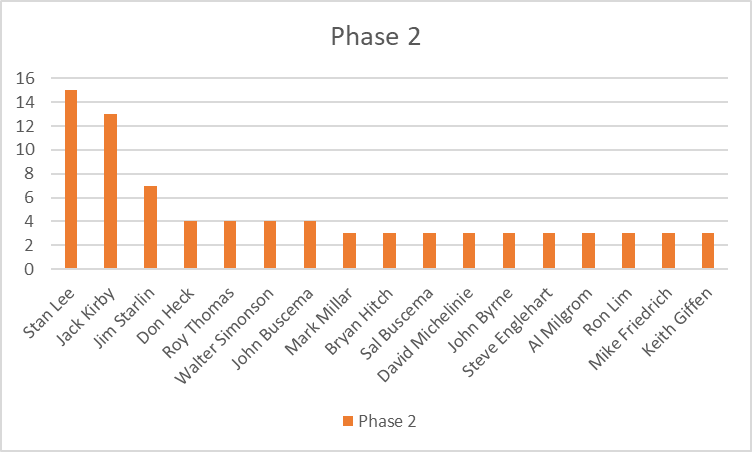
Phase 2 saw the introduction of a lot of cosmic elements in the MCU, which helped launch Starlin to the #3 spot. Unlike the first film, Thor: Dark World leveraged far more Simonson-era creations, making Simonson one of Phase 2's biggest contributors.
Byrne made it into the top ten thanks to his artistic contributions to the Avengers, Guardians of the Galaxy, and Ant-Man. Lim, Friedrich, and Giffen all worked extensively in Marvel's cosmic corner and owe the bulk of their Phase 2 creative credits to Guardians of the Galaxy.
Amongst all four phases, Phase 2 easily has the lowest average number of creative credits per creator. It is also the only phase that does not feature Brian Michael Bendis in the Top 10.
Phase 3 Breakdown
Captain America: Civil War, Doctor Strange, Guardians of the Galaxy Vol. 2, Spider-Man: Homecoming, Thor: Ragnarok, Black Panther, Avengers: Infinity War, Ant-Man and the Wasp, Captain Marvel, Spider-Man: Far From Home
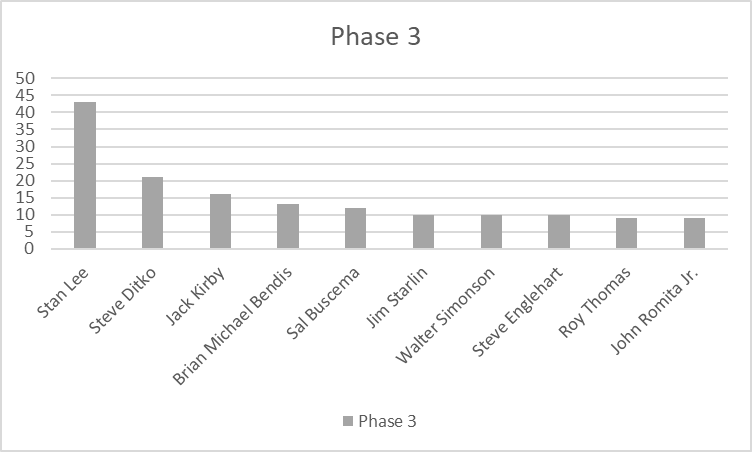
Phase 3 is the only phase thus far where someone other than Jack Kirby claims the #2 spot. This makes sense, as Phase 3 saw the introductions of Spider-Man and Doctor Strange, the two greatest creations of Steve Ditko.
Bendis made his way back into the top 10 thanks to the elements of Ultimate Spider-Man that showed up in Spider-Man: Homecoming and various elements of his extensive Avengers run that popped up across the films.
Phase 3's heavy use of cosmic elements ensured Starlin remained in the top 10, while the inclusion of two Avengers films created ample opportunities for elements from Roy Thomas and Steve Engelhart's respective runs on the Avengers title to make it into the MCU.
Phase 4 Breakdown
Black Widow, Shang-Chi and the Legend of the Ten Rings, Eternals, Spider-Man: No Way Home, Doctor Strange In The Multiverse of Madness, Thor: Love and Thunder, Black Panther: Wakanda Forever (Incomplete), WandaVision, The Falcon and the Winter Soldier, What If…?, Hawkeye, Moon Knight, Ms. Marvel, She-Hulk: Attorney At Law (Incomplete), I Am Groot (Incomplete)

Phase 4 is the only phase where Jack Kirby and Stan Lee have an equal number of creative credits. Phase 4 also marks the first appearances of Dan Slott and G. Willow Wilson on a top ten list. Slott's presence is due to his almost decade-long run on Amazing Spider-Man and his phenomenal work on She-Hulk, while Wilson appears due to her lengthy and incredible run writing Ms. Marvel
Breakdown By Franchise
Ant-Man Franchise Breakdown
Ant-Man, Ant-Man & The Wasp, Ant-Man & The Wasp: Quantumania (Incomplete)
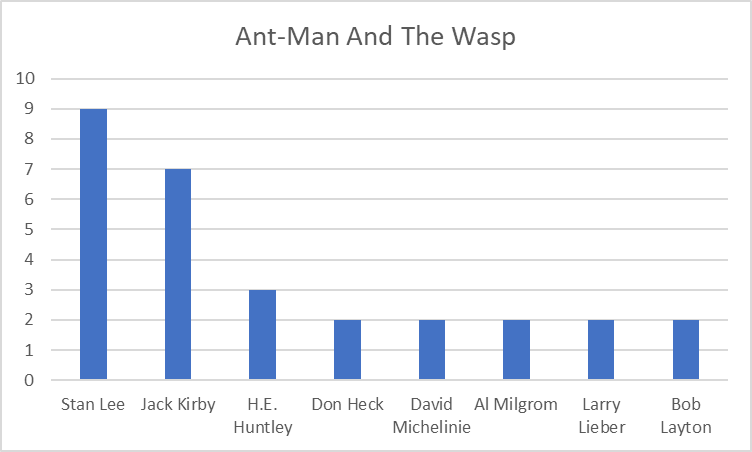
Ant-Man has not had a lot of success with solo stories, so there weren't a lot of stories the MCU could pull from besides the early works of Stan Lee and Jack Kirby. Out of all the books that influenced the Ant-Man franchise, only one of them had "Ant-Man" in the title
Avengers Franchise Breakdown
Avengers, Avengers: Age of Ultron, Avengers: Infinity War, Avengers: Endgame, Avengers: Kang Dynasty (Incomplete), Avengers: Secret Wars (Incomplete)
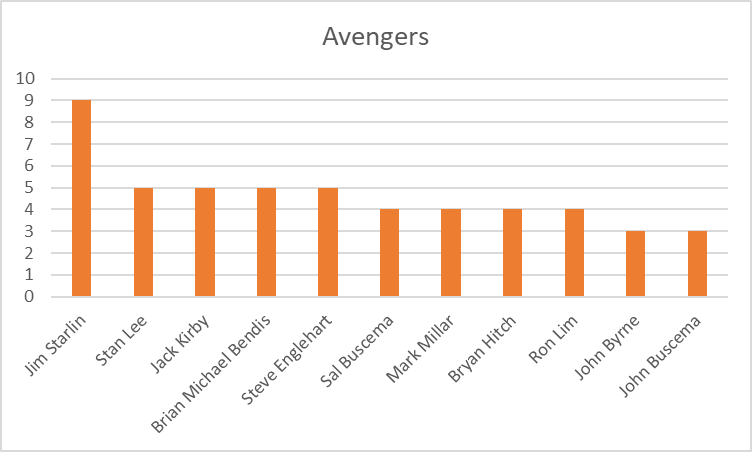
Three of the Four Avengers films are cosmic in nature and/or heavily incorporate cosmic characters, so it is not surprising that Starlin would show up in the top ten. Bendis wrote dozens of different Avengers books over the years, so it is only natural that he would appear on this list as well.
Black Panther Franchise Breakdown
Black Panther, Black Panther: Wakanda Forever (Incomplete)
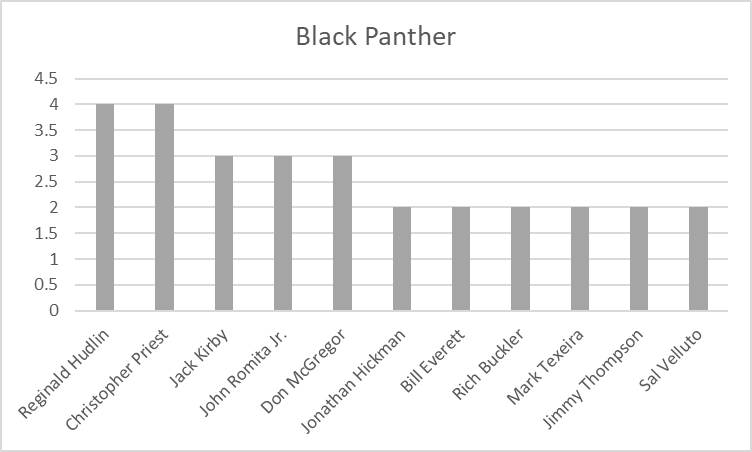
For fans of Black Panther comics, this graph could not be less surprising. Hudlin and Priest were the first two writers to write an ongoing series for the Black Panther. Jack Kirby created the character and frequently used him in different books.
Romita Jr was an artist on one of those series and is also so prolific that he has drawn Black Panther in a lot of different books.
Finally, Don McGregor wrote the acclaimed Panther Quest storyline, which was heavily leveraged by both Priest and Hudlin when they were writing their respective series.
Black Widow Franchise Breakdown
Black Widow
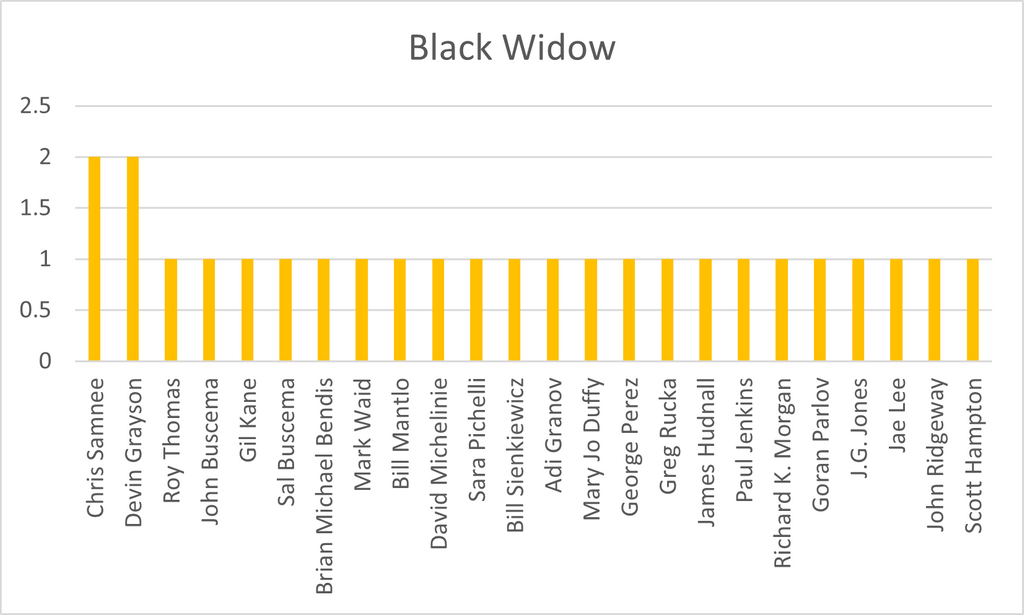
Black Widow has rarely been given the spotlight in Marvel Comics, so it only makes sense that her franchise would be an amalgamation of the work of several different contributors as opposed to the creative vision of one or a set of individuals
Captain America Franchise Breakdown
Captain America: The First Avenger, Captain America: The Winter Soldier, Captain America: Civil War, The Falcon And The Winter Soldier
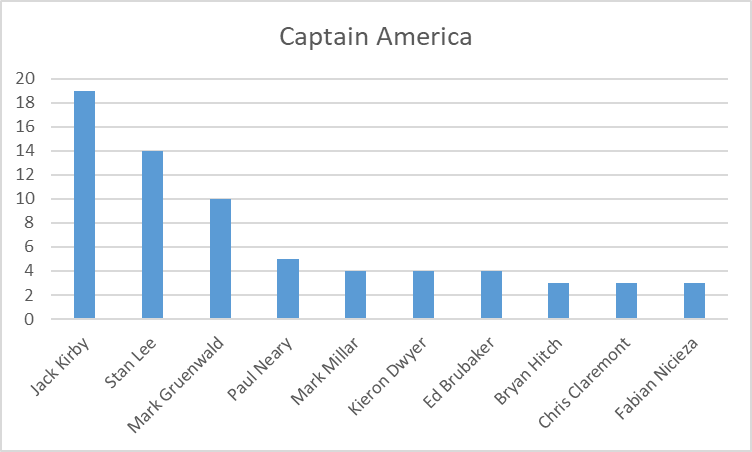
Jack Kirby co-created Captain America (along with the incomparable Joe Simon) and was one of the only artists to draw him for multiple decades, so it makes sense that he would claim the top spot.
Mark Gruenwald had an extensive run on Captain America and created USAgent, meaning he benefited tremendously from the latter's central role in The Falcon and the Winter Soldier.
The biggest surprise here is how far down on the list Ed Brubaker is, exposing one of the shortcomings of the particular methodology I used.
Doctor Strange Franchise Breakdown
Doctor Strange, Doctor Strange In The Multiverse Of Madness
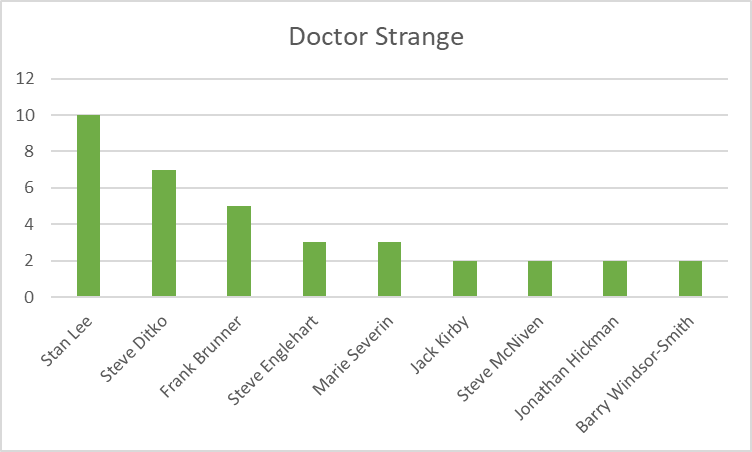
The first Doctor Strange movie was an origin story, so it makes sense that Stan Lee and Steve Ditko, who created the character's early stories, would claim the top two spots.
Meanwhile, Multiverse of Madness does not have a strong basis in any particular comic story or set of stories. As a result, most of the remaining creative credits are highly scattered.
Eternals Franchise Breakdown
Eternals
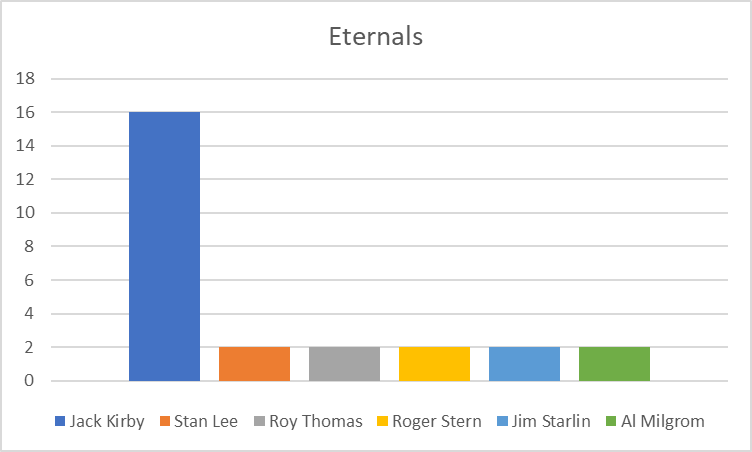
This is not particularly surprising, as Jack Kirby created the Eternals and the eponymous film was primarily based on Kirby's interpretation of the characters.
Guardians of the Galaxy Franchise Breakdown
Guardians Of The Galaxy, Guardians Of The Galaxy Vol. 2, Guardians of the Galaxy Vol. 3 (Incomplete), I Am Groot (Incomplete)
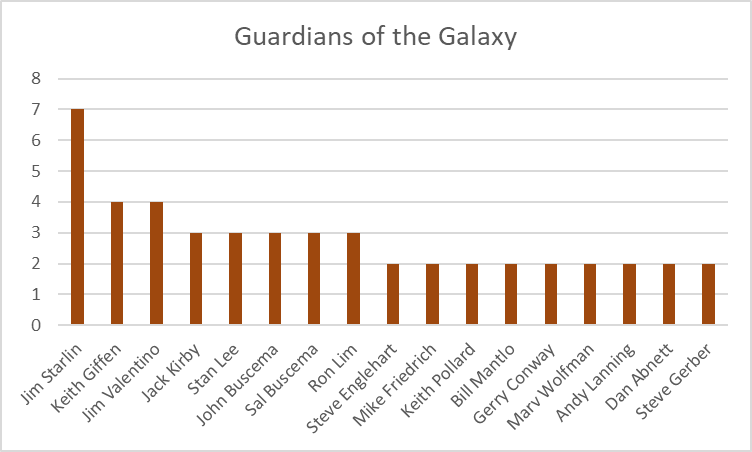
While Starlin is the biggest architect of Marvel's cosmic corner, he is not the only one. Keith Giffen wrote a lot of cosmic stories, including the transcendent Annihilation event that set the stage for a lot of modern cosmic stories.
The Guardians of the Galaxy films have liberally borrowed from different cosmic stories, leading to very diffuse creative credits.
Hawkeye Franchise Breakdown
Hawkeye
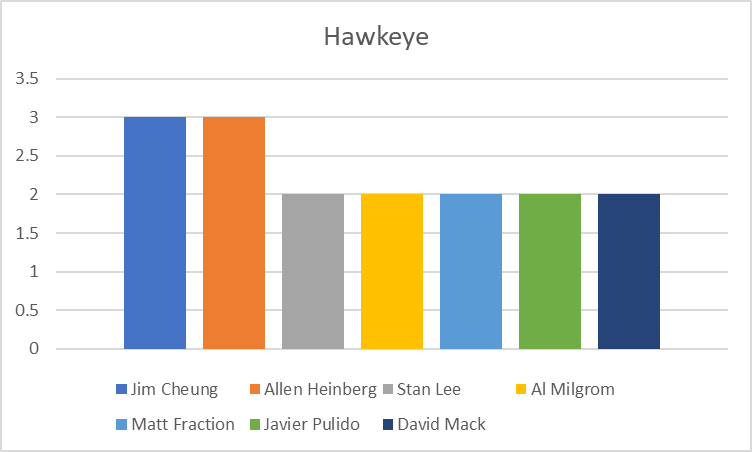
As the creators of Kate Bishop, Jim Cheung and Allen Heinberg were able to claim the top spots for Hawkeye. Like the Captain America franchise, the Hawkeye franchise does show some of the limitations of the chosen methodology.
The Hawkeye series heavily borrowed from Matt Fraction's acclaimed run on the Hawkeye comic, but this graph does not really capture that.
Hulk Franchise Breakdown
Incredible Hulk, She-Hulk: Attorney At Law (Incomplete)
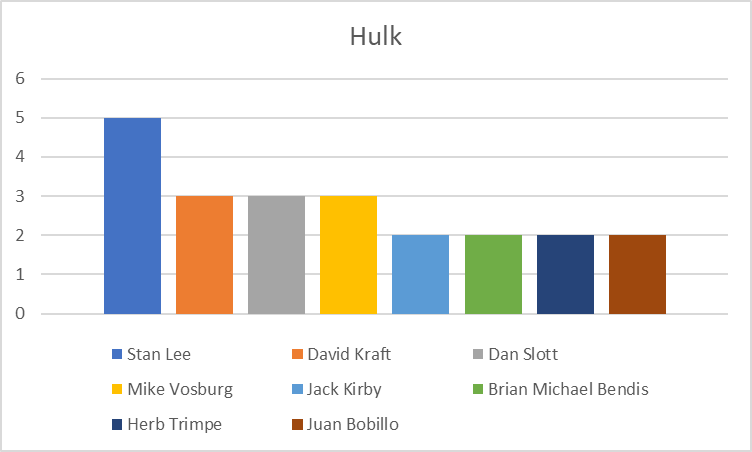
The Hulk franchise is probably the weirdest franchise of all. It has the longest gap between entries and the two entries could not be more different.
The Incredible Hulk was largely a by-the-numbers action-adventure story set in the earliest days of the then-fledgling cinematic universe.
She-Hulk: Attorney at Law, on the other hand, is an off-the-walls meta-comedy that occurs after more than a decade of prior storytelling.
Stan Lee claims the top spot as the creator of both Hulks.
Iron Man Franchise Breakdown
Iron Man, Iron Man 2, Iron Man 3, Ironheart (Incomplete), Armor Wars (Incomplete)
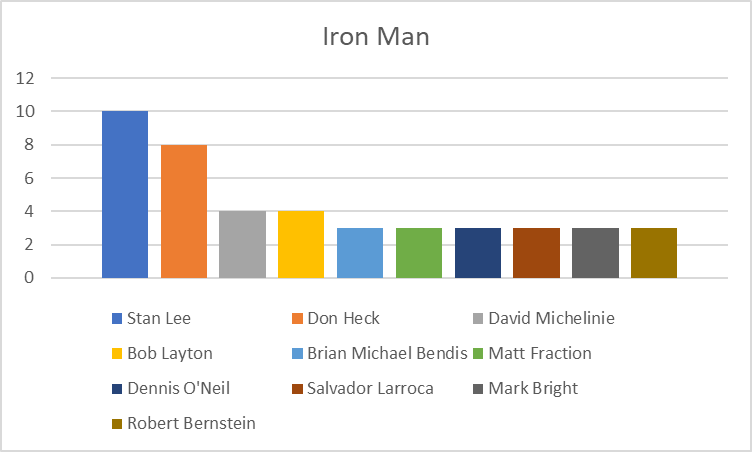
Iron Man is perhaps the most straightforward franchise there is. Every single person listed on this graph had an extensive run on a flagship Iron Man comic.
The Marvels Franchise Breakdown
Captain Marvel, Ms. Marvel, The Marvels (Incomplete)
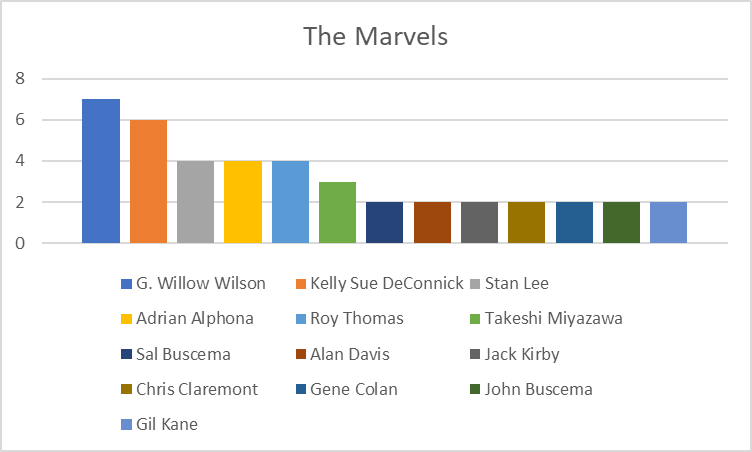
Almost every single Ms. Marvel story has been written by G. Willow Wilson and drawn by Adrian Alphona, while the MCU's version of Carol Danvers clearly takes its greatest inspiration from Kelly Sue DeConnick's run with the character.
Moon Knight Franchise Breakdown
Moon Knight

Moon Knight has had a lot of extremely different takes and interpretations over the years. Rather than focus on any one individual interpretation, the show found a way to masterfully mix them all together.
As a result, nobody other than Doug Moench (who wrote the character's early stories) really has a leg up in creative credits.
Shang-Chi Franchise Breakdown
Shang-Chi And The Legend Of The Ten Rings
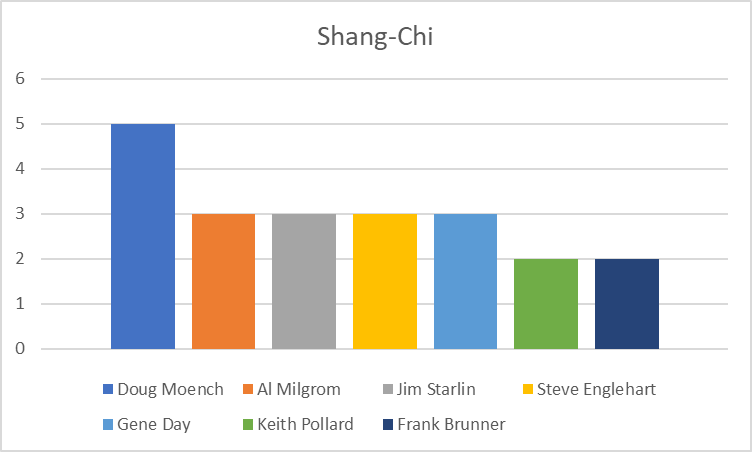
This graph is essentially just a list of people who have written Shang-Chi solo stories.
Spider-Man Franchise Breakdown
Spider-Man: Homecoming, Spider-Man: Far From Home, Spider-Man: No Way Home, Spider-Man: Freshman Year (Incomplete)
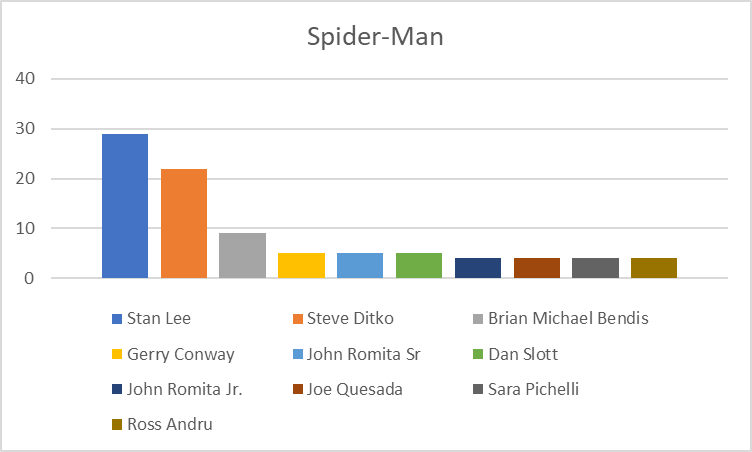
As the creators of Spider-Man, it makes sense that Stan Lee and Steve Ditko would claim the top 2 spots. Bendis comes in at #3 thanks to his extensive tenure writing Ultimate Spider-Man.
Sara Pichelli appears for a similar reason, but she is farther down on the list because she was not the only Ultimate Spider-Man artist, while Bendis was effectively the only Ultimate Spider-Man writer. Conway was the first regular writer of Amazing Spider-Man after Stan Lee and wrote dozens of other Spidey stories over the years.
Quesada made it on the list because No Way Home heavily leveraged One More Day, the awful story Quesada insisted had to be told.
Thor Franchise Breakdown
Thor, Thor: Dark World, Thor: Ragnarok, Loki, Thor: Love & Thunder
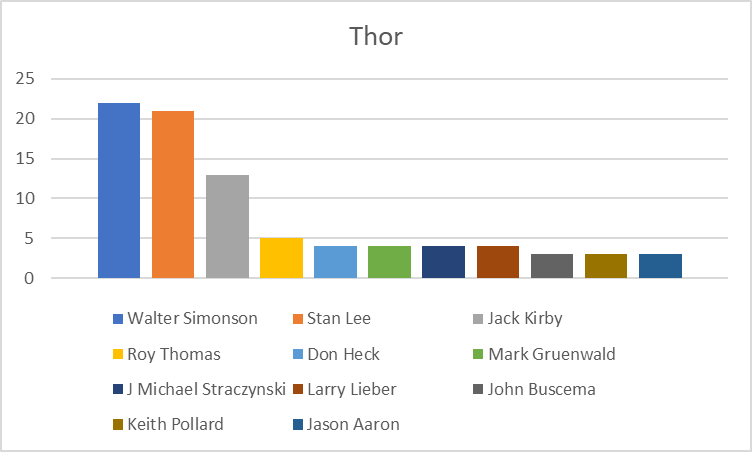
Simonson did not write Thor more than Stan Lee, nor did he draw Thor more than Jack Kirby. He is, however, the only person on this list who did both. As a result, he claims the top spot.
WandaVision Franchise Breakdown
WandaVision
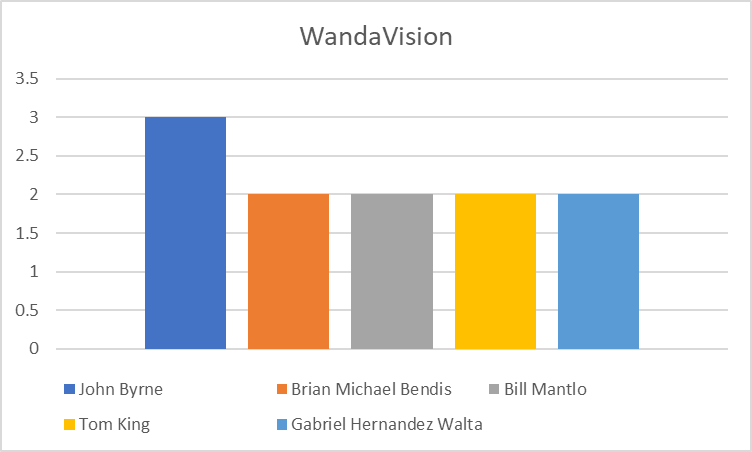
WandaVision borrows from a lot of different Scarlet Witch and Vision storylines over the years and, as a result, does not have a lot of creative credits from any particular creator.
What If…? Franchise Breakdown
What If…? Season 1
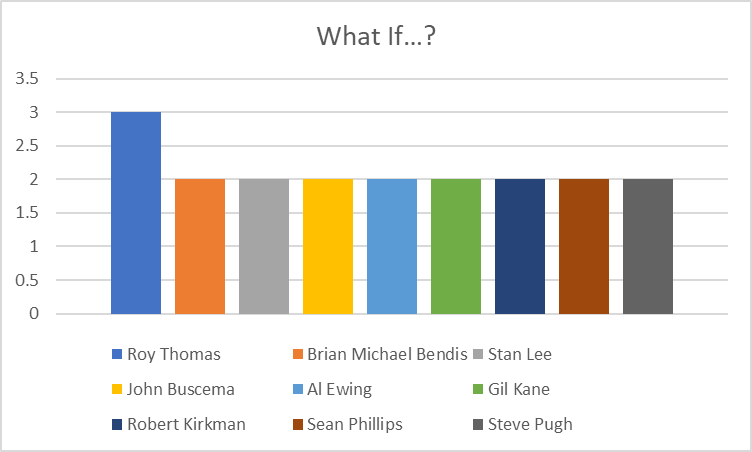
What If...?, by its very nature, is not built around a particular character or story and, consequently, does not have any creators particularly responsible for it.
Issues And Opportunities
In order for any of this information to be useful, it is important to understand the various issues and limitations that are at play. Otherwise, it would become perilously easy to draw conclusions that the data cannot substantiate.
First, it is important to remember that there was no weighting conducted as a part of this analysis. Amazing Fantasy #15 and Marvel Comics Presents Vol. 1 #19 are both listed as inspirations for Spider-Man: Homecoming. The importance of the former to the overall film is vastly greater than the latter, but that nuance is not reflected anywhere in the data.
Furthermore, the creative process is an incredibly nebulous one and credit is not always equally distributed. Brian Michael Bendis played a far bigger role in the creation of Miles Morales than Sara Pichelli, but are credited equally here. How exactly to account for and/or mitigate these issues is not clear and would likely involve adding significant complexity to the analysis. Were I to conduct this analysis again or work to expand it, I would probably try to figure out the weighting problem as well as more heavily research each individual film to determine the significance of any one individual comic.
Conclusion
I hope you enjoyed the article and found the analysis interesting. I love conducting these kinds of deep dives into data and would love to do it more. If that is something you are interested in, make sure to leave a comment letting me know what you are interested in and share the article with others. So, until next time, face front True Believers and make mine Marvel!
Are you a Pro yet?
*Any perceived investment advice is that of the freelance blogger and does not represent advice on behalf of GoCollect.
